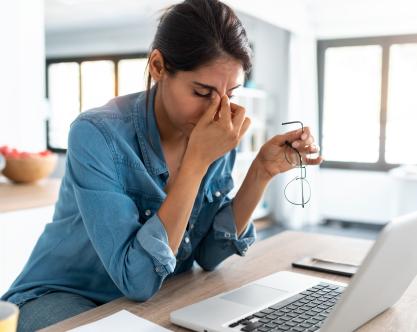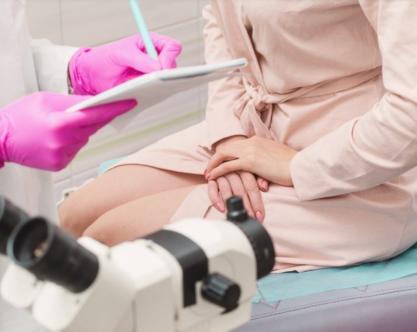
GYNECOLOGY
Looking after your vaginal health
Vaginal health is an important topic.
Women should understand what happens in their vagina and how it works.
Vaginal health is an oft-overlooked women’s health topic, with global studies underlining widespread misconceptions and a lack of informed advice. To prevent vaginal infections, women must first understand different vaginal conditions. In this article, we explore the latter in depth.
This page comprehensively reviews vaginal health, with a focus on vaginal microbiota, vaginal conditions and vaginal infection treatment. Rather than asking Google how to keep your vagina healthy, we suggest reading the scholar information provided below.
Learn more about :
- What happens in your vagina?
- What is vaginal microbiota?
- How to look after yourself to prevent vaginal conditions and infections? In other words, how do you know if you have an infection down there? How can I treat infection in my vagina?
Definition
Vaginal Microbiota : A delicate balance1
Derived from the Greek words micro (small) and bios (life), microbiota constitutes a critical, dynamic determinant of vaginal health. To address these women’s health issues, we must first understand how vaginal flora works and the role it plays in a woman’s lifetime.
What is vaginal microbiota? How does it work ?
We share our bodies with countless tiny microbes (microorganisms) that live on our skin, in our mouth, nose, intestine, and in our vagina.
Together these tiny organisms (bacteria, fungi, viruses…) make up the human microbiota. The human microbiota plays an essential role in human life by regulating our natural defenses against infections and ensuring our body functions.
Reverting to the vagina, vaginal microbiota forms a "community of microorganisms" that lives within your vagina. In collaboration with your immune system, the microbiota will act to prevent the installation of pathogenic bacteria. An adult woman has between 1 and 100 million bacterial cells per milliliter of secretions inside her vagina.
Most vaginal microbiota contain beneficial bacteria called Lactobacillus that play an essential role in preserving your vaginal health and protecting your vagina from aggressive microbes. Each woman has her own unique vaginal microbiota that maintains the right balance between the different microorganisms. Interestingly, it has recently been shown that the composition of the microbiota can vary according to geographic and ethnic origins 2-6.
What is the importance of Lactobacilli?
Lactobacillus bacteria dominate this natural defense system. Indeed, Lactobacilli play an essential part since they2,7:
- constitute the “normal” vaginal bacterial flora of healthy women.
- maintain a healthy acidic environment within the vagina (pH 3.5-4.5). This makes it inhospitable to other bacteria, thus preventing the risk of them growing and causing infections.
- can prevent pathogenic microorganisms from attaching to the lining of the vagina.
- naturally produce molecules which protect against harmful microbes (i.e., hydrogen peroxide, natural antibiotics called bacteriocins.)
- can also boost the immune defenses of the vagina and can have an antiviral action.
Vaginal Microbiota at every stage in a woman's life
The composition of the vaginal microbiota is strongly influenced by the level of hormones produced by a woman, especially by estrogens levels, the main female sex hormones. Thus, over the course of a woman’s life, the vaginal microbiota will evolve; these changes are normal 3, 4, 8-11.
Vaginal microbiota during childhood | During childhood, estrogen levels are low and little girls have no or little Lactobacilli. During puberty with hormonal changes in the body, the vaginal microbiota evolves into that of an adult woman with an increase of Lactobacilli and the acidification of the vagina. |
|---|---|
Vaginal microbiota during menstruation | Menstrual blood causes a temporary rise in the pH (becoming alkaline). This produces a drop in Lactobacilli numbers, which in turn makes it easier for other potentially harmful bacteria, such as Staphylococcus aureus to develop. Hence why tampons must be changed frequently (every 4 to 8 hours). As soon as your period ends The beneficial bacteria then increase the acidity of the vulva and the entire vaginal ecosystem, making it more capable of defending itself against harmful bacterial germs. |
Vaginal microbiota during pregnancy | Levels of estrogen (female hormone) increase progressively during pregnancy. This causes a rise in the number of Lactobacilli cells and the microbiota therefore remains stable over time whereas in non-pregnant women, the microbiota changes during the menstrual cycle. A stable microbiota is the first line defense against infections. The less positive and healthy aspect is that Candida fungi also begin to increase in numbers. This microscopic fungus normally lives in the vagina without causing any trouble, but if it grows too much can also cause vaginal yeast infection and affect discharge. This is why pregnant women are more frequently affected by yeast infections. |
Vaginal microbiota during postpartum period | Female hormone levels, which are elevated during pregnancy, drop significantly after delivery. Consequently, the quantity of Lactobacilli cells in the vagina diminishes to cause the balance of vaginal flora to be disturbed. Post-partum women are therefore much more prone to vaginal infections. |
Vaginal microbiota during menopause | During menopause, less estrogen is produced. As vaginal cells receive less estrogen, the vaginal wall becomes more vulnerable with dryness and the quantity of Lactobacilli in the vagina diminishes. Changes in vaginal microbiota during menopause increase the risk of vaginal infection. |
Causes
What affects vaginal health?
The cornerstone of vaginal health, vaginal microbiota can be unbalanced by multiple factors3, 5, 10-19:
- Age and changes in hormone levels and vaginal conditions: menstrual cycle, pregnancy, menopause, Genitourinary Syndrome of Menopause (GSM)
- Bad, unhygienic habits and practices: smoking, alcohol abuse, tight-fitting clothes, fabric types, deodorant, lubricants, perfumed bath products and excessive douching
- Sexual activity: numerous partners, unprotected sex
- Common diseases, e.g., diabetes
- Vaginal lubricants use
- Certain medications (antibiotics, glucocorticoids, antiseptics and antibacterial soaps)
- Emotional distress, such as stress
- Certain methods of contraception
How do these factors affect the balance of your vaginal microbiota? 3-5, 10, 20-23
Changes in estrogen secretion | The vaginal microbiota evolves over time and changes with age. It can vary at puberty, during and after pregnancy, and during menopause. Levels of Lactobacilli are strongly dependent on the quantity of hormones: the greater the levels of hormones, such as estrogen, the greater the concentrations of Lactobacilli and the level of protection for the vagina, thus maintaining your vaginal health and preventing from vaginal infection. |
|---|---|
Sexual activity | The number of sexual partners, certain sexual practices such as anal sex or sharing sexual accessories, and the frequency of intercourse can lead to an imbalance in the vaginal microbiota. If you have multiple sex partners, there may be changes in the vaginal microbiota; and the more partners one has throughout one's life, the greater the phenomenon, with a potential imbalance of the vaginal microbiota. It is important to remember to use condoms with a new partner until you have both been screened at a clinic for sexually transmitted infections (Chlamydia, Gonorrhea, Trichomonas…). Nevertheless, even if the test comes back negative, unprotected intercourse with a new partner or several partners increases the risk of some women’s health issues, such as vaginal microbiota imbalance and bacterial vaginosis. |
Tobacco | Smoking affects the immune system and stimulates bacterial aggressiveness. Also, female smokers have fewer protective lactobacilli. The higher the tobacco consumption is, the greater the risk to imbalance your vaginal microbiota is. Thus, smokers of ten cigarettes per day run twice the risk of developing bacterial vaginosis than non-smokers. |
Inappropriate hygiene habits that may increase the risk vaginal health issues and infections: |
|
Stress | Women prone to stress are more likely to suffer from vaginal conditions, such as yeast infections and bacterial vaginosis. Thus, women exposed to chronic psycho-social stress have a 30% additional risk of developing bacterial vaginosis. Change your unhealthy habits to:
|
Certain medications (such as antibiotics, antiseptics, glucocorticoids) and certain types of contraception |
|
Warning !
Never stop the treatment prescribed by your doctor without medical advice on the pretext of preserving your vaginal health and well-being. Ask your pharmacist or doctor for advice and they can recommend an alternative treatment that will have a lower impact on the vaginal microbiota or an additional treatment such as probiotics which help restore the balance of vaginal microbiota.
If the vaginal microbiota gets out of balance, the risk of infection is greater.
Common vaginal health issues
Notwithstanding sexually transmitted infections (STIs), the most frequent women’s health issues center on sexual problems, vaginitis, vaginal cysts and cancer – which can be linked to vaginal infection24.
What are vaginal infections ?
They denote a set of etiologically diverse vaginal conditions. As detailed below, notable infections include vulvovaginal candidiasis, bacterial vaginosis, bacterial vaginitis, trichomoniasis and mixed vaginitis.
Women who have repeated vaginal infections see their quality of life strongly altered.
How do you know if you have an infection down there?
If you experience itching, burning, discharge or an unpleasant smell in the genital area, it may be a sign that you have a vaginal infection25-33.
Diverse vaginal infections
VULVOVAGINAL CANDIDIASIS | Vulvovaginal candidiasis (or yeast infection) is a vaginal condition which is caused by an excess of yeast in the vagina (Candida albicans or Candida non-albicans). Studies have shown that 70-75% of women will be affected by vulvovaginal candidiasis in their lifetime, with up to 24% having recurrent Vulvovaginal candidiasis. This condition is often mixed with other infections (bacterial vaginosis, bacterial vaginitis, or trichomoniasis) and clinical symptoms are sometimes indistinguishable. This infection affects both the vulva and the vagina. Candida is normally present in the vagina of most women, but also in other parts of the body such as the urinary tract, the intestine and the skin. It exists different subtypes of Candida (Candida albicans, glabrata, krusei, etc…). In the vagina, Candida develops as harmless spores. But under the influence of external events, the latter cells begins to make hyphae (filamentous form) that gradually penetrate the vaginal wall and damage it. This aggression causes inflammation and pain, itching, burning, white discharge... In addition, Candida secretes toxins which aggravate local inflammation. Some situations, such as antibiotic or corticosteroid use, pregnancy, diabetes and cancer may be linked to Candida growth. Vulvovaginal candidiasis is usually not transmitted sexually 25, 27, 31-36. |
BACTERIAL VAGINOSIS | Bacterial vaginosis is the most common vaginal condition, especially during menopause. This vaginal infection is caused by a change in the delicate balance of naturally occurring, common bacteria in the vagina’s flora: Lactobacilli — the “friendly” bacteria — drop in numbers and are replaced by another bacteria called Gardnerella vaginalis and other mainly anaerobic bacteria (that do not require oxygen), which change the pH of the vagina (becoming more alkaline). Lactobacilli play an essential role in maintaining vaginal health and protecting female genitals from aggressive microbes. A depletion of these bacteria imbalances the vaginal microbiota and allows the proliferation of harmful bacteria throughout the vagina such as Prevotella spp., Gardnerella vaginalis, Atopobium vaginae… Having multiple sex partners, a new sex partner, douching, lack of condom use, increases the risk of bacterial vaginosis. Furthermore, women with bacterial vaginosis are at increased risk for the acquisition of some sexually transmitted infections. such as Human Immunodeficiency Virus (HIV) or, Trichomoniasis, as well as obstetrical complications such as preterm birth25, 27, 28, 31, 37, 38. |
BACTERIAL VAGINITIS | Bacterial vaginitis refers to a decrease in Lactobacilli associated with an overgrowth of aerobic bacteria, notably E.coli or other bacteria cells such as Staphylococcus or Streptococcus (bacteria that come mainly from the gut and are therefore part of the gut microbiota). This vaginal condition may cause obstetrical complications and may heighten the risk of contracting sexually transmitted infections such as Human Immunodeficiency Virus (HIV) or Chlamydia trachomatis39. |
TRICHOMONIASIS | Trichomoniasis is a sexually transmitted infection, caused by a parasite called Trichomonas vaginalis. This condition is a common cause of vaginitis, and most infections of the vagina are asymptomatic, but over 50% of affected women show vaginal discharge. Women with bacterial vaginosis are at higher risks for acquiring Trichomonas vaginalis. Trichomoniasis can be associated with obstetrical complications or infertility and with an augmented risk of HIV aquisition31,40, 41, 42. |
MIXED VAGINITIS | This vaginal health condition highlights the simultaneous presence of at least two pathogenic bacteria. The variability of the symptoms makes it difficult to diagnose. For instance, a study found that 20%-30% of women with bacterial vaginosis are also infected with Candida species and over half of women with bacterial vaginitis would have mixed infections with vulvovaginal candidiasis, bacterial vaginosis or with trichomoniasis29, 33. |
Signs and Symptoms
Vaginal conditions can often be detected through a range of physical signs. Common symptoms may include an increase in vaginal discharge, sometimes accompanied by a noticeable odor, frequent itching, and visible signs of inflammation, which can vary depending on the specific infection25-27, 30, 31.
In vulvovaginal candidiasis (yeast vulvovaginal infection)
Both the vulva and the vagina are affected.
The main symptoms to watch out for are:
- Irritation and burning sensations,
- Vulvar and vaginal itching,
- Abnormal vaginal discharge (white, thick and curdy),
- Pain during sexual intercourse and urination.
These symptoms cause discomfort and pain that can vary but are often severe.
In bacterial vaginosis
This type of infection can be asymptomatic, but in more than 50% of the cases, bacterial vaginosis is associated with a thin and white or grey vaginal discharge, and often include an unpleasant and typical ”fishy” smell that may become more noticeable after intercourse or during your period.
Most of the time, bacterial vaginosis is not associated with vaginal inflammation and does not cause irritation of the vulva or pain during intercourse.
In bacterial vaginitis
What does vaginitis look like? Contrary to bacterial vaginosis and as with all forms of vaginitis, bacterial vaginitis is characterized by an inflammation of the vagina, with irritation and burning. It is accompanied by unusual vaginal discharge often yellowish.
In trichomoniasis
(Trichomonas vaginalis infection)
The discharge is frothy and greenish-yellow. This vaginal condition can be associated with symptoms of urethritis.
Although some women are asymptomatic, Women with trichomoniasis frequently experience pain during sexual intercourse or when urinating.
If you are diagnosed with a sexually transmitted infection, your sex partner will need to be treated too.
Be careful !
Unpleasant or bothersome symptoms may not be due to vaginal conditions or infections. They can be caused by allergic or irritant reactions to personal hygiene products, or due to lower levels of estrogen (as can be seen in women during or after menopause).
That is why it is so important to talk and seek medical advice..
Your doctor will:
- ask questions about your medical history,
- perform a physical gynecological examination,
- conduct or prescribe office-based or laboratory tests where necessary.
Only then will your doctor be able to make the right diagnosis and prescribe the most appropriate treatment for you.
Treatment
How to treat vaginal infections ?
Vaginal infections treatment includes pills via oral administration or vulvovaginal local medication (pessaries, creams or soft capsules).
Your doctor will prescribe a treatment that combats the cause(s) of your infection and that is adapted to your medical situation14-16, 27, 28, 31, 43-46.
Diagnosis and medical examination
Symptoms of vaginal infections can vary greatly.
There is no specific symptom that distinguishes one infection from another. Identifying the exact cause is therefore complex, especially since one symptom can have several causes, and some women have multiple causes (i.e., multiple symptoms!).
Think about it…
2 out of 3 women who self-diagnose and use vaginal antifungals, (often purchased directly at the pharmacy without prescription) do not actually have vulvovaginal candidiasis!
Certain bacteria are resistant to some treatments. This means that the wrong treatment will have no effect and the problem and symptoms will persist. Remember that some anti-infective treatments may damage the naturally present, protective Lactobacilli bacteria.
So, you see, only your doctor can make the correct diagnosis, providing the right information and prescribing the right treatment.
The sooner you make an appointment, the better.
Treatment
You may be wondering: “How can I treat infection in my vagina? How do I get rid of a bacterial infection?.” Below, those answers you have been looking for!
- Various treatments exist such as antibiotics, antifungals and associations of both.
- Vaginal infection treatments can include oral treatment by pills or intravaginal medication with different pharmaceutical forms.
- If you experience difficulties in the use of solid pharmaceutical forms into your vagina (for example, in case of pain or dryness in the vagina), talk to your doctor or your pharmacist. Application of a vaginal cream or vulvo-vaginal instillation of the treatment with a specific pharmaceutical form may be done.
- All these treatments have their proper microbial activity and different durations of treatment.
- It is important to remember that some vaginal treatments such as creams or pessaries may not be compatible with certain types of condoms, because of their oil-based nature. Read the leaflet of the treatment you are taking to find out if this is the case.
Once you have been given the right treatment, remember to follow your prescription carefully. Take your treatment for the full recommended time - never stop just because the symptoms subside. Treatment duration times have been carefully determined for maximum efficacy.
If you do stop before the recommended treatment end, the infection will remain active and very likely flare up again soon. Even worse, the bacteria may become resistant to the treatment, which will likely not be at all effective next time you take it.
Tips for my partner
I have a vaginal infection. What shoud my partner do?
Tips for your partner:
- If you have a vaginal condition, your partner should take extra care to wash its genitals daily using mild soap or specially formulated product while avoiding anything antiseptic. But remember, thorough cleaning does not equal more washes!
- Women partners must not overwash but ensure timely medical check-ups.
- Uncircumcised men partners will be more affected; they should regularly pull back their foreskin and check the glans for redness.
- If the glans becomes red, it does not necessarily mean he has a yeast infection. He should never use an antifungal cream without first seeing his doctor.
What can I do to keep my vagina healthy ?
Your body is your temple; so too is your vagina. To optimize vaginal health, consider how each woman’s physiological needs differ. You need to find out you own! Overall, a healthy vagina equals a balanced vaginal microbiota which requires good bacteria and a restored pH balance. So, how do you manage this process?
How do you increase good bacteria in vagina ?51
Some obvious vaginal treatment tips include a balanced diet with consumption in moderation, wearing breathable clothing made from cotton and refraining from artificial cleaning products wherever possible.
You may be wondering: How to preserve the balance of the vaginal flora?
Here are our recommendations:
- Limiting your consumption of processed food rich in fat and carbohydrates;
- cutting down on sugar (soda, ice cream, candy, etc.);
- and practicing yoga, meditation, and any of your fun, healthy hobbies, to de-stress!
How to prevent my vaginitis from coming back ?3-5,7,8,13-20,52,53
1: Practice safer sex
During sex, your vagina comes into contact with unknown bacteria from your partner. If you have a new partner, use a condom to avoid sexually transmitted infections. You might want to consider using condoms with your regular partner if you often experience bacterial vaginosis.
2: Avoid smoking
Make important lifestyle changes. Women who smoke have fewer vaginal Lactobacilli which can therefore cause more recurring symptoms and greater risk of infection from harmful bacteria. If you smoke, reduce your consumption until you ideally phase it out completely. Remember, the risk far outweighs the benefit(s)!
3: Limit antibiotics & antiseptics 17, 20
Overuse of either of these will destroy not only the harmful bacteria but also the good ones. It is also important not to “do it yourself”: do not self-medicate when you can talk to a professional doctor who can prescribe you the appropriate vaginal treatment.
4: Avoid vaginal douching or harsh cleaners & soaps
- Since the vagina is a "self-cleaning" organ, you should never use vaginal douching (even with water alone). It is best to let your vagina clean itself naturally by making mucus, which washes away blood, semen, and vaginal discharge.
- There is therefore no point in internal douching, otherwise the self-cleaning mechanism of the vagina and its microbiota will be impaired. In addition, the water removes the protective mucus of the vagina and its lactobacilli and can change the pH of your vagina, increasing the risk of infection.
- Cleaning should be limited to the external area alone.
5: Don't over-wash
Washing your external genitals once daily with an appropriate intimate hygiene product is enough.
Too much hygiene (especially when using classic soap instead of adapted product for intimate hygiene) is as harmful to vaginal health as poor hygiene. Indeed, it can disrupt your normal vaginal microbiota and dry out the mucous membrane. So, one external wash per day is sufficient.
6: Wipe from front to back
Always wipe from front to back until the toilet paper is clean. The best way to prevent bacteria from getting into the vagina. Otherwise, the chances of transferring harmful bacteria to the vulva, the vagina and the urinary tract are high.
7: Renew tampons or sanitary pads
Tampons and sanitary pads must be changed frequently during your period. Tampons must be changed every three to four hours and never kept for more than eight hours at night, otherwise there is a risk of vaginal infection with the development of toxic bacteria. Furthermore, tampons should neither be scented nor made with bleaching chemicals.
8: Avoid intimate perfumes & deodorants
They can affect the delicate balance of microbiota and cause irritation.
Any genital odors are either physiological - so with good normal hygiene the use of deodorants is not justified - or pathological, sign that there is some sort of infection, such as bacterial vaginosis. If that is case, the deodorant will only mask the problem without solving it and possibly even make it worse. Please consult your doctor if you notice any unusual vaginal odors.
9: Avoid tight clothes and underwear in synthetic fabrics
Synthetic underwear is unable to absorb perspiration as effectively as cotton underwear. The moisture leads to an increased risk of vaginal infections.
10: Change underwear frequently
However, avoid using tampons or protective pads outside of your period. They are likely to damage the wall of the vagina or cause dryness of the vulva by absorbing the natural secretions, which in turn may cause an imbalance of your vaginal microbiota. Avoid unnecessary risks. Also, it is useless to get into the habit of introducing tampons as a preventive measure before going to a swimming pool to avoid getting a new mycosis. It is better to put on a dry swimsuit or underwear as soon as you get out of the water.
Tips for my daughter
Tips for my daughter to maintain a good vaginal health
We suggest 3 vaginal health tips:
Take the time to practice the dos and don’ts of basic hygiene. The younger your daughter, the better, as she will develop good habits more quickly.
Show her proper toilet practices; not holding on too long before going; not pressing legs together; and wiping herself from front to back after urinating or defecating.
- Teach her the importance of wearing loose, cotton underwear.
Talking about vaginal health with my daughter
Mothers play an essential role in instructing their daughters about personal hygiene.
A young girl’s vulva is delicate, even more so than that of an adult woman. Good hygiene practice starts early.
Mothers must encourage little girls to take the time they need to ensure they are clean, to wash the genital area by hand, to clean around the anus properly, to rinse carefully, and lastly, to dry the area thoroughly with a clean towel.
Avoid harsh soaps and bubble bath as well as tight-fitting clothing and synthetic underwear.
Little girls should not hold on too long before going to the toilet. While urinating, they should not press legs tightly together.
Wiping is important; teach your little girl how to wipe herself after urinating or defecating, and to do it properly, from front to back.
Always seek medical advice if your little girl's vulva seems red and irritated, or if there is an abnormal discharge11, 18, 54-56.
Why is your daughter's vaginal microbiota different from yours?
The composition of the vaginal microbiota changes over time, based on changing estrogen levels.
Vaginal microbiota of young girls do not include Lactobacilli and its pH is neutral.
In the peripubertal period (starting around 7 years of age), sex hormone secretion begins and increases as puberty progresses. These hormonal changes, and specifically the increase of estrogen, will cause the vaginal microbiota of a young girl to evolve into that of an adult woman with the onset of Lactobacilli and the acidification of the vagina11.
My daughter suffers from vaginitis, what should I do?
Vulvovaginitis is extremely frequent in young girls.
As a mother, you can help by making sure she follows good personal hygiene habits (keeps her genital area clean and dry, wipe from front to back and changes underwear frequently).
And remember that the most important first step is to consult your doctor.
This will ensure you get the right diagnosis and the correct treatment for your daughter11, 54-57.
Key takeaways
What shall you keep in mind on the vaginal microbiota ? 2-4
- The term vaginal microbiota refers to the different bacteria that live inside the vagina.
- Both the gut and vaginal microbiota of each woman are unique and change continuously throughout her life.
- Lactobacilli are the healthy bacteria; in a healthy vagina, they outnumber the harmful bacteria, thus protecting the vagina from infection.
- A healthy lifestyle with good intimate hygiene is essential to maintaining a healthy vaginal microbiota, thereby avoiding infections.
- Don't hesitate to talk to your doctor, and make that visit to their clinic!
Vaginal infections: What you should keep in mind ? 14-16, 28, 31, 43
- Vaginal infections are frequent during your reproductive years but can also affect young girls and postmenopausal women
- Vaginal infections occur when there is an imbalance in the proportions of bacteria in the vagina—the vaginal microbiota.
- When harmful bacteria outnumber the natural protective bacteria, this creates an environment where unwanted bacteria or yeast can develop.
- In some cases, such as trichomoniasis, pathogens are acquired only through sexual activity.
Remember !
- Different bacteria cause different types of vaginal infections.
- Treatment must be tailored to each individual situation.
- The earlier you seek medical advice, the earlier you can start the right treatment, and the sooner the infection will be cured.
- Attempting to make your own diagnosis can lead to the wrong treatment, which increases the risk of the infection coming back.
- Always seek medical advice if you have questions about your vaginal health. Only your doctor can give you reliable information, clear guidance, and a medical prescription adapted to your particular case.
References
1. Berg G, Rybakova D, Fischer F, Cernava T, Vergès M-CC, Charles T, et al. Microbiome definition re-visited: old concepts and new challenges. Microbiome. 2020;8:103. doi: 10.1186/s40168-020-00875-
2. Diop K, et al. Exhaustive repertoire of human vaginal microbiota. Hum Microb J. 2019;11:100051. https://doi.org/10.1016/j.humic.2018.11.002.
3. Gupta S, et al. Crosstalk between vaginal microbiome and female health: a review. Microb Pathog. 2019;136:103696. https://doi.org/10.1016/j.micpath.2019.103696.
4. Krishna SBN, et al. The vaginal microbiota in women health and disease: current understanding and future perspectives – A review. Curr Trends Biotechnol Pharm. 2017;11(2):190-205.
5. Amabebe E, et al. The vaginal microenvironment: the physiologic role of Lactobacilli. Front Med (Lausanne). 2018;5:181.
6. Archana Pant, Bhabatosh Das, Chapter Ten - Microbiome-based therapeutics: Opportunity and challenges 2022; 229-262. https://doi.org/10.1016/bs.pmbts.2022.07.006.
7. Kovachev S. Defence factors of vaginal lactobacilli. Crit Rev Microbiol. 2018;44:31-9.
8. Greenbaum S, et al. Ecological dynamics of the vaginal microbiome in relation to health and disease. Am J Obstet Gynecol. 2019;220:324-35.
9. Kroon SJ, et al. Cervicovaginal microbiota, women’s health, and reproductive outcomes. Fertil Steril. 2018;110:327-36.
10. Kaur H, et al. Crosstalk between female gonadal hormones and vaginal microbiota across various phases of women’s gynecological lifecycle. Front Microbiol. 2020;11:151.
11. Neyazi SM. Prepubertal vaginitis. J Nat Sci Med. 2019;2:14-22.
12. Muhleisen AL, et al. Menopause and the vaginal microbiome. Maturitas. 2016;91:42-50.
13. Barrientos-Durán A, et al. Reviewing the composition of vaginal microbiota: inclusion of nutrition and probiotic factors in the maintenance of eubiosis. Nutrients. 2020;12:419-49.
14. Ferris DG, et al. Over-the-counter drug misuse associated with patient-diagnosed vulvovaginal candidiasis. Obstet Gynecol. 2002;99:419-425.
15. Angotti LB, et al. Vaginitis: making sense of over-the counter treatment options. Infect Dis Obstet Gynecol. 2007; Article ID 97424. doi:10.1155/2007/97424.
16. Sihvo S, et al. Self-medication with vaginal antifungal drugs: physicians’ experiences and women’s utilization patterns. Fam Pract. 2000;17:145-9.
17. Chen Y, et al. Role of female intimate hygiene in vulvovaginal health: global hygiene practices and product usage. Women’s Health. 2017;13(3):58-67.
18. Cottrell BH. Vaginal douching. J Obstet Gynecol Neonatal Nurs. 2003;32:12-8.
19. Bohbot JM, et al. Microbiote vaginal: la révolution rose. Marabout. 2018.
20. Gonçalves B, et al. Vulvovaginal candidiasis: Epidemiology, microbiology and risk factors. Critical Reviews in Microbiology 2016 42:6 (905-927)
21. Nastel T.R. et al. The association of psychosocial stress and bacterial vaginosis in a longitudinal cohort. Am J Obstet Gynecol. 2006 February; 194(2): 381–386.
22. Screening Recommendations and Considerations Referenced in Treatment Guidelines and Original Sourceshttps://www.cdc.gov/std/treatment-guidelines/screening-recommendations.htm
23. Vodstrcil LA, Muzny CA, Plummer EL, Sobel JD, Bradshaw CS. Bacterial vaginosis: drivers of recurrence and challenges and opportunities in partner treatment. BMC Med. 2021 Sep 2;19(1):194. doi: 10.1186/s12916-021-02077-3. PMID: 34470644; PMCID: PMC8411528.
24. Mayo clinic. Vagina: what's typical, what's not. https://www.mayoclinic.org/healthy-lifestyle/womens-health/in-depth/vagina/art-20046562. Accessed on April 23th 2024.
25. Paladine HL, et al. Vaginitis: diagnosis and treatment. Am Fam Physician. 2018;97:321-9.
26. Sherrard J, et al. 2018 European (IUSTI/WHO) International Union against sexually transmitted infections (IUSTI) World Health Organisation (WHO) guideline on the management of vaginal discharge. Int J STD AIDS. 2018;29:1258-72.
27. Hainer BL, et al. Vaginitis: diagnosis and treatment. Am Fam Physician. 2011;83:807-15.
28. Jones A. Bacterial Vaginosis: a review of treatment, recurrence, and disparities. J Nurse Pract. 2019;15:420-3.
29. Sobel JD, et al. Mixed vaginitis – more than coinfection and with therapeutic implications. Curr Infect Dis Rep. 2013;15:104-8.
30. Aballéa S, et al. Subjective health status and health related quality of life among women with recurrent vulvovaginal candidosis (RVVC) in Europe and the USA. Health Qual Life Outcomes. 2013;11:169.
31. Centers for Disease Control and Prevention. Sexually transmitted diseases treatment guidelines, 2015. Reviewed 2021. [on line]. https://www.cdc.gov/std/treatment-guidelines/STI-Guidelines-2021.pdf
32. Rodríguez-Cerdeira C, et al. Biofilms and Vulvovaginal Candidiasis. Colloids Surf B Biointerfaces. 2019 Feb 1;174:110-125.
33. Fan A, et al. Aerobic vaginitis and mixed infections: comparison of clinical and laboratory findings. Arch Gynecol Obstet. 2013; 287:329-35.
34. Farr A, Effendy I, Frey Tirri B, Hof H, Mayser P, Petricevic L, Ruhnke M, Schaller M, Schaefer APA, Sustr V, Willinger B, Mendling W. Guideline: Vulvovaginal candidosis (AWMF 015/072, level S2k). Mycoses. 2021 Jun;64(6):583-602. doi: 10.1111/myc.13248. Epub 2021 Feb 27. PMID: 33529414; PMCID: PMC8248160.
35. Donders G, Sziller IO, Paavonen J, Hay P, de Seta F, Bohbot JM, Kotarski J, Vives JA, Szabo B, Cepuliené R, Mendling W. Management of recurrent vulvovaginal candidosis: Narrative review of the literature and European expert panel opinion. Front Cell Infect Microbiol. 2022 Sep 9;12:934353. doi: 10.3389/fcimb.2022.934353. PMID: 36159646; PMCID: PMC9504472.
36. Yu D, Liu Z. The research progress in the interaction between Candida albicans and cancers. Front Microbiol. 2022 Sep 28;13:988734. doi: 10.3389/fmicb.2022.988734. PMID: 36246294; PMCID: PMC9554461.
37. Bradshaw CS, Morton AN, Hocking J, Garland SM, Morris MB, Moss LM, Horvath LB, Kuzevska I, Fairley CK. High recurrence rates of bacterial vaginosis over the course of 12 months after oral metronidazole therapy and factors associated with recurrence. J Infect Dis. 2006 Jun 1;193(11):1478-86. doi: 10.1086/503780. Epub 2006 Apr 26. PMID: 16652274.
38. Mohanty T, Doke PP, Khuroo SR. Effect of bacterial vaginosis on preterm birth: a meta-analysis. Arch Gynecol Obstet. 2023 Oct;308(4):1247-1255. doi: 10.1007/s00404-022-06817-5. Epub 2022 Oct 17. PMID: 36251068.
39. Donders, Gilbert G. G., Gert Bellen, Svitrigaile Grinceviciene, Kateryna Ruban, et Pedro Vieira-Baptista. « Aerobic Vaginitis: No Longer a Stranger ». Research in Microbiology, Special Issue on Vaginal microbiology, 168, no 9 (1 novembre 2017): 845-58.
40. World Health Organization. Trichomoniasis. https://www.who.int/news-room/fact-sheets/detail/trichomoniasis. Accessed on April 23th 2024.
41. Vieira-Baptista, Pedro, Colleen K. Stockdale, et Jack Sobel, éd. International Society for the Study of Vulvovaginal Disease Recommendations for the Diagnosis and Treatment of Vaginitis. Ad Médic, Lda., 2023.
42. NHS. Trichomoniasis. https://www.nhs.uk/conditions/trichomoniasis/ Accessed on April 23th, 2024.
43. Bradshaw CS, et al. Current treatment of bacterial vaginosis—limitations and need for innovation. J Infect Dis. 2016:214 (Suppl 1):S14-20.
44. Melkumyan AR, et al. Effects of antibiotic treatment on the lactobacillus composition of vaginal microbiota. Bull Exp Biol Med. 2015;158:766-8.
45. Neut C, et al. Topical treatment of infectious vaginitis: effects of antibiotic, antifungal and antiseptic drugs on the growth of normal vaginal 15. Lactobacillus strains. Open Journal of Obstetrics and Gynecology. 2015;5:173-80.
46. Vieira-Baptista, Pedro, Silva Ana Rita, Costa Mariana, Figueiredo Rita, , Sousa Carlos, International Journal of Gynecology & Obstetrics, Volume 156, Issue 3, March 2022, pp. 552-559: Diagnosis of bacterial vaginosis: clinical or microscopic? A cross-sectional study, First published: June 23 2021
47. Nappi RE, Liekens G, Brandenburg U. Attitudes, perceptions and knowledge about the vagina: the International Vagina Dialogue Survey. Contraception. 2006 May;73(5):493-500. doi: 10.1016/j.contraception.2005.12.007. Epub 2006 Feb 17. PMID: 16627033.
48. Mayo Clinic. Yeast infection in men: How can I tell if I have one?, https://www.mayoclinic.org/male-yeast-infection/expert-answers/faq-20058464 Accessed on April 23rd, 2024.
49. Gray RH, Kigozi G, Serwadda D, Makumbi F, Nalugoda F, Watya S, Moulton L, Chen MZ, Sewankambo NK, Kiwanuka N, Sempijja V, Lutalo T, Kagayii J, Wabwire-Mangen F, Ridzon R, Bacon M, Wawer MJ. The effects of male circumcision on female partners' genital tract symptoms and vaginal infections in a randomized trial in Rakai, Uganda. Am J Obstet Gynecol. 2009 Jan;200(1):42.e1-7. doi: 10.1016/j.ajog.2008.07.069. Epub 2008 Oct 30. PMID: 18976733; PMCID: PMC2727852.
50. Wigan R, Vaughn C, Vodstrcil L, Doyle M, Kaiser M, McGuiness C, Bradshaw CS, Bilardi JE. "It's just an issue and you deal with it… you just deal with it, you move on and you do it together.": Men's experiences of bacterial vaginosis and the acceptability of male partner treatment. PLoS One. 2020 Jun 29;15(6):e0235286. doi: 10.1371/journal.pone.0235286. PMID: 32598394; PMCID: PMC7323956.
51. Lehtoranta L, Ala-Jaakkola R, Laitila A, Maukonen J. Healthy Vaginal Microbiota and Influence of Probiotics Across the Female Life Span. Front Microbiol. 2022 Apr 8;13:819958. doi: 10.3389/fmicb.2022.819958. PMID: 35464937; PMCID: PMC9024219.
52. Felix T.C, et al. Evaluation of Vulvovaginitis and Hygiene Habits of Women Attended in Primary Health Care Units of the Family. International Journal of Women's Health 2020:12 49–57
53. Liverpool Women’s NHS Foundation Trust. General Care of the Vulval Skin Information Leaflet. https://www.liverpoolwomens.nhs.uk/media/2912/general-care-of-the-vulval-skin-gyn_2019-231-v1.pdf . Accessed on July 26th 2024.
54. Beyitler I, et al. Clinical presentation, diagnosis and treatment of vulvovaginitis in girls: a current approach and review of the literature. World J Pediatr. 2017;13(2):101-5.
55. Lanis A, et al. Prepubertal and adolescent vulvovaginitis: what to do when a girl reports vaginal discharge. Pediatr Ann. 2020;49(4):e170-e175.
56. Zukerman, et al. Clinical recommendation: vulvovaginitis. J Pediatr Adoles Gynecol. 2016;29:673-9.
57. Joishy M, et al. Do we need to treat vulvovaginitis in prepubertal girls? BMJ. 2005;330:186-8.






